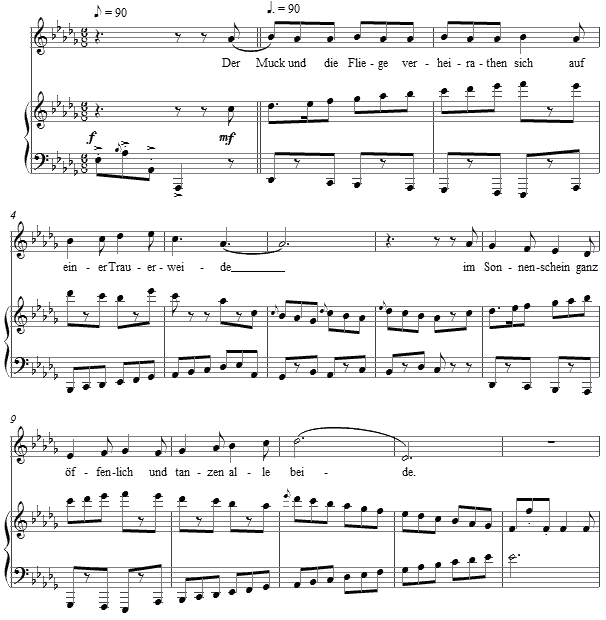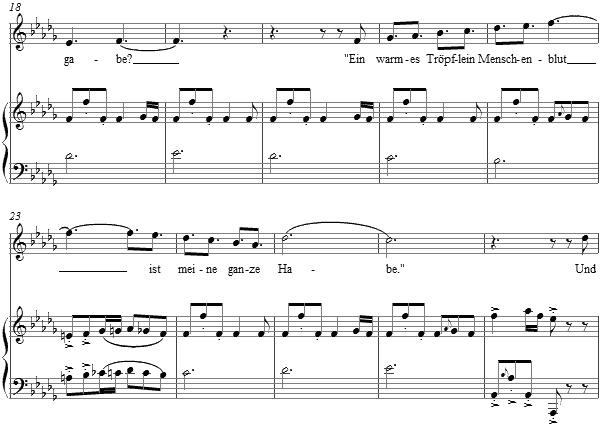Music and Texts of GARY BACHLUND
Vocal Music | Piano | Organ | Chamber Music | Orchestral | Articles and Commentary | Poems and Stories | Miscellany | FAQs
Kurze Freude - (2008)
August Heinrich Hoffmann von Fallersleben
for medium voice and piano
Der Muck und die Fliege verheirathen sich [ 1 ]
Auf einer Trauerweide
Im Sonnenschein ganz öffentlich
Und tanzen alle beide.
Und was soll sein dein Heirathsgut
Und deine Morgengabe?
«Ein warmes Tröpflein Menschenblut
Ist meine ganze Habe.»
Und was soll sein dein Sommergemach,
Wo wir uns traulich finden?
«Ein frischer, blumiger, heller Bach
Im Schatten breiter Linden.»
Und was soll sein dein Winterlosier,
Wann's friert an Ohren und Händen?
«Da nehmen wir beim Bauern Quartier,
Spazieren an seinen Wänden.»
Noch tanzen sie, noch freu'n sie sich
Auf ihrer Trauerweide --
Da kommt ein Rothschwanz listiglich [ 2 ]
Und erschnappt sie alle beide.[ 4 pages, circa 1' 40" ]
Hoffmann von Fallersleben
This humorous poem tells a five-stanza tale of "Brief Joy," for such is life, says the poet to us from another age. Other setting of texts by von Fallersleben as the three humorous songs, Mäuselein, Mauskätzchen und Spätzchen, and the three lullabies, Wiegenlieder,
The gnat and the flea got married one day
Out on a weeping willow tree
In the summer sun quite openly, they
Then danced -- both gnat and flea.
And what shall be for your wedding bed
And your bridegroom's wedding gift?
"A warm little drop of blood quite red
Is what I think I've sniffed."
And what shall be for your summer's ease,
When days are quite cozy and free?
"A fresh, flowery stream, if you please,
In the shade of a lime-laden tree.
And what shall be for your wintertime
When ears and hands are quite frozen?
"Why, then we'll summer inside for I'm
Sure inside's some wall we will have chosen."
Then how they danced on their wedding day
Upon their weeping willow tree --
Then came a cunning red bird straight away
And ate both that gnat and his flea.
Rhymed translation by the composer
Set for medium voice and piano, this little romp through the five stanzas is in chain form - A / B / C / B / A with a short coda. The opening texture is a simple two part invention of voices moving in opposition.
The B section "straightens out" the vocal line into a duple rhythm over the ongoing 6/8 beneath, as the tonal center of the tonic major yields to a new storytelling element.
The center section is more chordal, and then the pattern reverses, with a second B section followed by a recapitulation of the opening two-part "invention." For a coda, the last line of the poem is restated as the piano accompaniment breaks into a 3/4 diatonic climb up the octave to the final tonic, and a last harsh comment of the ultimate and often unavoidable brutality of life and death.
The score for Kurze Freude is available as a free PDF download, though any major commercial performance or recording of the work is prohibited without prior arrangement with the composer. Click on the graphic below for this piano-vocal score.



